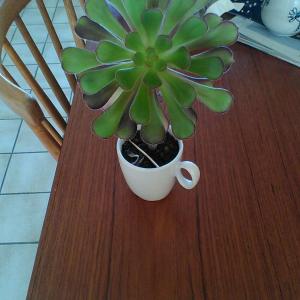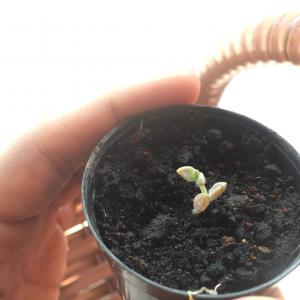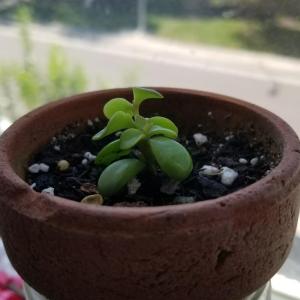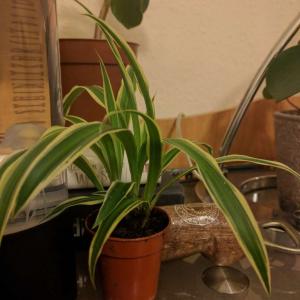求助
Dorre
2017年10月29日

I have no idea wich plant this is. Can someone help me?


0
0
Brittany Paterson NJ:@Dorre it doesn’t necessarily need more- if you want it to be sun stressed (so it turns color) you’ll need more though! If it’s looking stretched out and leggy like it’s reaching toward the sky (most succulents are supposed to be small,tight, and compact.) then it really NEEDS more light!
Dorre:@Brittany Paterson NJ thanks 😊 I Just got him so it's Nice to know that it needs sunlight
Brittany Paterson NJ:It’s an Aeonium! More sun or artificial grow light will make the entire thing turn a beautiful deep purple/burgundy.
文章
Miss Chen
2017年10月28日

The gray mold fungus is the main cause of mold in strawberries (Fragaria x ananassa). Gray mold, Botrytis cinerea, usually affects strawberries growing in cold or damp conditions and it makes them inedible. Contact with decayed plant material also helps spread gray mold. Strawberries grow in U.S. Department of Agriculture plant hardiness zones 2 through 11, depending on the variety. Buying new, disease-free plants every year helps reduce problems with mold.

Causes of Mold
Mold overwinters in plant debris and on living plants that carry the disease, and infects strawberries when conditions are right. Ripe, red strawberries or unripe green strawberries can suffer from mold, but the fungus most quickly affects ripening fruit.
Contact with soil, dead leaves and infected fruit spreads the mold fungus. Fungus spores can also spread through people touching infected fruits and then healthy fruits, and on the wind. Gray mold develops when temperatures are between 70 and 80 degrees Fahrenheit. Wet weather, high humidity and overhead watering also encourage mold growth. Overfertilizing strawberry plants creates lush, soft growth that's vulnerable to mold attack.
Symptoms of Infection
Strawberries infected with gray mold develop minor symptoms that gradually become worse. Infections often begin under the small leaves surrounding the strawberry stalks. Light brown spots appear, which grow larger and develop gray, dusty mold that covers the whole fruit. Strawberry fruits infected with gray mold usually maintain their shape. Infected fruits don't recover. In unfavorable conditions, such as dry, warm air and good air circulation, the disease progresses slowly. The strawberry plant's eaves and stems usually look normal, though gray mold can spread up strawberry stalks.

Preventing Mold
Avoiding crowding and shady sites and use other =controls help prevent mold in strawberries. Grow strawberry plants 2 feet apart in rows 18 inches apart in open, full-sun sites. Stagger the plants so that they are diagonally opposite in their rows.
Water strawberries with drip irrigation or soaker hoses, and not with a watering can, garden hose or sprinklers. Spread a sheet of woven plastic that allows water to penetrate, or another mulch, between the plants to prevent fruits from touching the soil. Suitable mulches include clean straw, sawdust and paper. Don't fertilize strawberries in spring, but wait until after harvesting the fruits. Apply a 16-16-16 fertilizer at a rate of 1 1/2 pound for each 100 square feet, when the strawberry leaves are dry. Don't allow the fertilizer to touch the leaves.
Removing dead and diseased fruits and foliage also helps prevent gray mold from spreading. Sterilize pruning shears by wiping the blades with a cloth that was dipped in rubbing alcohol, before and after pruning strawberries.
Treating Mold
Regular spraying with a fungicide helps protect strawberries from mold. Put on long pants, a long-sleeved shirt, safety goggles and gloves before spraying strawberries with fungicides.
On a dry, still day in spring, when new growth appears on the strawberries, dilute a fungicide containing 48.9 percent N-trichtoromethylthio~cyclohexene-1,2-dicarboximide at a rate of 2 level tablespoons per 1 gallon of water. One gallon of solution treats 100 square feet of strawberry plants. Spray the plants, covering all plant surfaces, and spray them again every seven days until harvest. Manufacturers' instructions vary from product to product, so always read the product label and follow the instructions. Make sure any product you buy is safe to use on edibles.

Causes of Mold
Mold overwinters in plant debris and on living plants that carry the disease, and infects strawberries when conditions are right. Ripe, red strawberries or unripe green strawberries can suffer from mold, but the fungus most quickly affects ripening fruit.
Contact with soil, dead leaves and infected fruit spreads the mold fungus. Fungus spores can also spread through people touching infected fruits and then healthy fruits, and on the wind. Gray mold develops when temperatures are between 70 and 80 degrees Fahrenheit. Wet weather, high humidity and overhead watering also encourage mold growth. Overfertilizing strawberry plants creates lush, soft growth that's vulnerable to mold attack.
Symptoms of Infection
Strawberries infected with gray mold develop minor symptoms that gradually become worse. Infections often begin under the small leaves surrounding the strawberry stalks. Light brown spots appear, which grow larger and develop gray, dusty mold that covers the whole fruit. Strawberry fruits infected with gray mold usually maintain their shape. Infected fruits don't recover. In unfavorable conditions, such as dry, warm air and good air circulation, the disease progresses slowly. The strawberry plant's eaves and stems usually look normal, though gray mold can spread up strawberry stalks.

Preventing Mold
Avoiding crowding and shady sites and use other =controls help prevent mold in strawberries. Grow strawberry plants 2 feet apart in rows 18 inches apart in open, full-sun sites. Stagger the plants so that they are diagonally opposite in their rows.
Water strawberries with drip irrigation or soaker hoses, and not with a watering can, garden hose or sprinklers. Spread a sheet of woven plastic that allows water to penetrate, or another mulch, between the plants to prevent fruits from touching the soil. Suitable mulches include clean straw, sawdust and paper. Don't fertilize strawberries in spring, but wait until after harvesting the fruits. Apply a 16-16-16 fertilizer at a rate of 1 1/2 pound for each 100 square feet, when the strawberry leaves are dry. Don't allow the fertilizer to touch the leaves.
Removing dead and diseased fruits and foliage also helps prevent gray mold from spreading. Sterilize pruning shears by wiping the blades with a cloth that was dipped in rubbing alcohol, before and after pruning strawberries.
Treating Mold
Regular spraying with a fungicide helps protect strawberries from mold. Put on long pants, a long-sleeved shirt, safety goggles and gloves before spraying strawberries with fungicides.
On a dry, still day in spring, when new growth appears on the strawberries, dilute a fungicide containing 48.9 percent N-trichtoromethylthio~cyclohexene-1,2-dicarboximide at a rate of 2 level tablespoons per 1 gallon of water. One gallon of solution treats 100 square feet of strawberry plants. Spray the plants, covering all plant surfaces, and spray them again every seven days until harvest. Manufacturers' instructions vary from product to product, so always read the product label and follow the instructions. Make sure any product you buy is safe to use on edibles.
0
0
文章
Miss Chen
2017年10月28日

The gray mold fungus is the main cause of mold in strawberries (Fragaria x ananassa). Gray mold, Botrytis cinerea, usually affects strawberries growing in cold or damp conditions and it makes them inedible. Contact with decayed plant material also helps spread gray mold. Strawberries grow in U.S. Department of Agriculture plant hardiness zones 2 through 11, depending on the variety. Buying new, disease-free plants every year helps reduce problems with mold.

Causes of Mold
Mold overwinters in plant debris and on living plants that carry the disease, and infects strawberries when conditions are right. Ripe, red strawberries or unripe green strawberries can suffer from mold, but the fungus most quickly affects ripening fruit.
Contact with soil, dead leaves and infected fruit spreads the mold fungus. Fungus spores can also spread through people touching infected fruits and then healthy fruits, and on the wind. Gray mold develops when temperatures are between 70 and 80 degrees Fahrenheit. Wet weather, high humidity and overhead watering also encourage mold growth. Overfertilizing strawberry plants creates lush, soft growth that's vulnerable to mold attack.
Symptoms of Infection
Strawberries infected with gray mold develop minor symptoms that gradually become worse. Infections often begin under the small leaves surrounding the strawberry stalks. Light brown spots appear, which grow larger and develop gray, dusty mold that covers the whole fruit. Strawberry fruits infected with gray mold usually maintain their shape. Infected fruits don't recover. In unfavorable conditions, such as dry, warm air and good air circulation, the disease progresses slowly. The strawberry plant's eaves and stems usually look normal, though gray mold can spread up strawberry stalks.

Preventing Mold
Avoiding crowding and shady sites and use other =controls help prevent mold in strawberries. Grow strawberry plants 2 feet apart in rows 18 inches apart in open, full-sun sites. Stagger the plants so that they are diagonally opposite in their rows.
Water strawberries with drip irrigation or soaker hoses, and not with a watering can, garden hose or sprinklers. Spread a sheet of woven plastic that allows water to penetrate, or another mulch, between the plants to prevent fruits from touching the soil. Suitable mulches include clean straw, sawdust and paper. Don't fertilize strawberries in spring, but wait until after harvesting the fruits. Apply a 16-16-16 fertilizer at a rate of 1 1/2 pound for each 100 square feet, when the strawberry leaves are dry. Don't allow the fertilizer to touch the leaves.
Removing dead and diseased fruits and foliage also helps prevent gray mold from spreading. Sterilize pruning shears by wiping the blades with a cloth that was dipped in rubbing alcohol, before and after pruning strawberries.
Treating Mold
Regular spraying with a fungicide helps protect strawberries from mold. Put on long pants, a long-sleeved shirt, safety goggles and gloves before spraying strawberries with fungicides.
On a dry, still day in spring, when new growth appears on the strawberries, dilute a fungicide containing 48.9 percent N-trichtoromethylthio~cyclohexene-1,2-dicarboximide at a rate of 2 level tablespoons per 1 gallon of water. One gallon of solution treats 100 square feet of strawberry plants. Spray the plants, covering all plant surfaces, and spray them again every seven days until harvest. Manufacturers' instructions vary from product to product, so always read the product label and follow the instructions. Make sure any product you buy is safe to use on edibles.

Causes of Mold
Mold overwinters in plant debris and on living plants that carry the disease, and infects strawberries when conditions are right. Ripe, red strawberries or unripe green strawberries can suffer from mold, but the fungus most quickly affects ripening fruit.
Contact with soil, dead leaves and infected fruit spreads the mold fungus. Fungus spores can also spread through people touching infected fruits and then healthy fruits, and on the wind. Gray mold develops when temperatures are between 70 and 80 degrees Fahrenheit. Wet weather, high humidity and overhead watering also encourage mold growth. Overfertilizing strawberry plants creates lush, soft growth that's vulnerable to mold attack.
Symptoms of Infection
Strawberries infected with gray mold develop minor symptoms that gradually become worse. Infections often begin under the small leaves surrounding the strawberry stalks. Light brown spots appear, which grow larger and develop gray, dusty mold that covers the whole fruit. Strawberry fruits infected with gray mold usually maintain their shape. Infected fruits don't recover. In unfavorable conditions, such as dry, warm air and good air circulation, the disease progresses slowly. The strawberry plant's eaves and stems usually look normal, though gray mold can spread up strawberry stalks.

Preventing Mold
Avoiding crowding and shady sites and use other =controls help prevent mold in strawberries. Grow strawberry plants 2 feet apart in rows 18 inches apart in open, full-sun sites. Stagger the plants so that they are diagonally opposite in their rows.
Water strawberries with drip irrigation or soaker hoses, and not with a watering can, garden hose or sprinklers. Spread a sheet of woven plastic that allows water to penetrate, or another mulch, between the plants to prevent fruits from touching the soil. Suitable mulches include clean straw, sawdust and paper. Don't fertilize strawberries in spring, but wait until after harvesting the fruits. Apply a 16-16-16 fertilizer at a rate of 1 1/2 pound for each 100 square feet, when the strawberry leaves are dry. Don't allow the fertilizer to touch the leaves.
Removing dead and diseased fruits and foliage also helps prevent gray mold from spreading. Sterilize pruning shears by wiping the blades with a cloth that was dipped in rubbing alcohol, before and after pruning strawberries.
Treating Mold
Regular spraying with a fungicide helps protect strawberries from mold. Put on long pants, a long-sleeved shirt, safety goggles and gloves before spraying strawberries with fungicides.
On a dry, still day in spring, when new growth appears on the strawberries, dilute a fungicide containing 48.9 percent N-trichtoromethylthio~cyclohexene-1,2-dicarboximide at a rate of 2 level tablespoons per 1 gallon of water. One gallon of solution treats 100 square feet of strawberry plants. Spray the plants, covering all plant surfaces, and spray them again every seven days until harvest. Manufacturers' instructions vary from product to product, so always read the product label and follow the instructions. Make sure any product you buy is safe to use on edibles.
0
0
文章
Miss Chen
2017年10月27日

The best fungicide for tomatoes, or any other kind of plant, is prevention. Fungicides can protect a plant if they are used before any kind of fungal infection begins. Once a fungus attacks a plant, eliminating it isn't easy. You can control its spread by continuing to spray uninfected parts of the plant, but there is little chance of stopping a fungus once it starts. Proper planting and care practices are your best weapons against tomato fungus.

Prevention
Plant tomatoes when the soil has warmed to 55 degrees Fahrenheit and the night air temperatures are in the 50s. Give the plants plenty of air circulation for when they reach their mature size; don't crowd them. Plant them in full sun in rich soil, and water only at the base of the plants, not from above with a hose or sprinkler. Wet foliage encourages fungal disease. Don't overfertilize tomatoes. A handful of tomato fertilizer and a handful of lime added to the hole when planting is all they need for the season. Plant tomatoes in a different spot every three years to prevent diseases from building up in the soil.
Septoria Blight
After the first fruits set on the plant, the lower leaves of the plant can become infected with white or gray spots with a black or brown margin. Pick off infected leaves, and discard them in the garbage. Spray the plant with an organic fungicide containing copper or a synthetic fungicide labeled for use on vegetables or one containing Chlorothalonil. Septoria spreads quickly in wet weather, so be sure the plants are well spaced, and avoid working among them when they're wet. Clean up all refuse in the fall, so the fungus doesn't overwinter in the debris.

Early Blight
Dark brown or black spots can appear on the lower leaves of the plant after the plant has set plenty of fruit. Rings appear inside the spot, making it resemble a bull's eye. The fungus attacks the stems and fruit, too, producing black, sunken spots. Leaves yellow and drop off. Pick off infected leaves and fruit, and cut off affected stems, dipping your pruners in a one-part-bleach, nine-parts-water solution between each cut. At the first sign of trouble, begin spraying the plants with an organic fungicide containing copper or a synthetic fungicide containing Clorothalonil or Mancozeb.
Late Blight
Late blight appears toward the end of the growing season when night temperatures begin to cool. Black, wet-looking spots start at the leaf edge and spread inward. Wet weather aids the spread of the fungus, and it affects the fruit, as well, with rough, dark brown patches. Remove infected plant parts, and spray with an organic fungicide containing copper or a synthetic fungicide containing Chlorothalonil or Mancozeb.

Prevention
Plant tomatoes when the soil has warmed to 55 degrees Fahrenheit and the night air temperatures are in the 50s. Give the plants plenty of air circulation for when they reach their mature size; don't crowd them. Plant them in full sun in rich soil, and water only at the base of the plants, not from above with a hose or sprinkler. Wet foliage encourages fungal disease. Don't overfertilize tomatoes. A handful of tomato fertilizer and a handful of lime added to the hole when planting is all they need for the season. Plant tomatoes in a different spot every three years to prevent diseases from building up in the soil.
Septoria Blight
After the first fruits set on the plant, the lower leaves of the plant can become infected with white or gray spots with a black or brown margin. Pick off infected leaves, and discard them in the garbage. Spray the plant with an organic fungicide containing copper or a synthetic fungicide labeled for use on vegetables or one containing Chlorothalonil. Septoria spreads quickly in wet weather, so be sure the plants are well spaced, and avoid working among them when they're wet. Clean up all refuse in the fall, so the fungus doesn't overwinter in the debris.

Early Blight
Dark brown or black spots can appear on the lower leaves of the plant after the plant has set plenty of fruit. Rings appear inside the spot, making it resemble a bull's eye. The fungus attacks the stems and fruit, too, producing black, sunken spots. Leaves yellow and drop off. Pick off infected leaves and fruit, and cut off affected stems, dipping your pruners in a one-part-bleach, nine-parts-water solution between each cut. At the first sign of trouble, begin spraying the plants with an organic fungicide containing copper or a synthetic fungicide containing Clorothalonil or Mancozeb.
Late Blight
Late blight appears toward the end of the growing season when night temperatures begin to cool. Black, wet-looking spots start at the leaf edge and spread inward. Wet weather aids the spread of the fungus, and it affects the fruit, as well, with rough, dark brown patches. Remove infected plant parts, and spray with an organic fungicide containing copper or a synthetic fungicide containing Chlorothalonil or Mancozeb.
0
0
softwpeach
2017年10月27日

I was watering my plants and I saw this little plant on the ground, so I put it in a little pot but I wanna know what plant it is. #Identification #help


0
0
求助
Taurus_Girl
2017年10月26日

I got this plant as a present but wasn't told what kind it is. Can anyone help??


1
0
aureus90:Hi I think it's a small jade plant
文章
Miss Chen
2017年10月26日

Not only are grapes a healthy food to eat, but few things taste any better than fresh grapes plucked straight from the vine. In addition, because grapes grow in virtually every area of the country, all it takes is a spot to plant them and most home gardeners can enjoy this tasty fruit fresh from their own vines. However, grape vines take time to grow and to become established before they begin producing fruit.
Harvest Time

One mature vine can produce 10 lbs. or more of fresh grapes per season.
Grape vines require patience. The first several years after grape vines are planted they do not produce fruit. During those first few years grape vine's root structure grows and the vine develops strong and numerous branches to hold all those grapes it eventually produces. But do not expect to see any grapes until at least the third year. In addition, it takes about five to six years for grapevines to begin producing a consistent, heavy crop of grapes. But the wait is worth it -- one mature vine can produce 10 lbs. or more of fresh grapes per season.
Selecting a Site

When planting in rows, the vines receive more sunlight if planted in a north-to-south direction and that results in higher-quality grapes.
Because grape vines take at least three years to begin producing fruit, planting represents a long-term commitment. Once established, with proper care grape vines can live and produce grapes for 50 to 100 years. So plant the vines in the right spot, because it disrupts their growth to move them. Choose a sunny, well-drained area to ensure reliable production of quality grapes. In climates where spring frost is possible, select a sheltered spot. When planting in rows, the vines receive more sunlight if planted in a north-to-south direction and that results in higher-quality grapes.
Basic Grape Categories

A local nursery will have a selection of grapes that grow best in your area.
With hundreds of different cultivars there is plenty of choice. To help make your decision, it helps to know that there are four basic categories of grapes, Muscadine (Vitis rotundifolia), American (Vitis labrusca), European (Vitis vinifera) and French hybrids, which are crosses of V. vinifera cultivars with wild American species that are resistant to disease, according to West Virginia University Extension. Regardless of your choice, all grapevine varieties take about the same time before they begin producing fruit. In addition, a local nursery will have a selection of grapes that grow best in your area.
Choosing Grape Vines

Grapes come in seeded or seedless varieties in many different colors including white, green, red, black, blue-black and purplish. Decide if you want to grow bunch grapes, which includes Concord, or Muscadine grapes, which includes Scuppernogs, or grow both. Bunch grapes are self-fertile and can be planted alone or with other varieties. Keep in mind that some grapes are more high-maintenance than others. While the American grape varieties are resistant to disease, the vinifera type grapes need periodic chemical sprays during the year to control pests. American and French-American hybrids are the most commonly grown types for home gardens.
Harvest Time

One mature vine can produce 10 lbs. or more of fresh grapes per season.
Grape vines require patience. The first several years after grape vines are planted they do not produce fruit. During those first few years grape vine's root structure grows and the vine develops strong and numerous branches to hold all those grapes it eventually produces. But do not expect to see any grapes until at least the third year. In addition, it takes about five to six years for grapevines to begin producing a consistent, heavy crop of grapes. But the wait is worth it -- one mature vine can produce 10 lbs. or more of fresh grapes per season.
Selecting a Site

When planting in rows, the vines receive more sunlight if planted in a north-to-south direction and that results in higher-quality grapes.
Because grape vines take at least three years to begin producing fruit, planting represents a long-term commitment. Once established, with proper care grape vines can live and produce grapes for 50 to 100 years. So plant the vines in the right spot, because it disrupts their growth to move them. Choose a sunny, well-drained area to ensure reliable production of quality grapes. In climates where spring frost is possible, select a sheltered spot. When planting in rows, the vines receive more sunlight if planted in a north-to-south direction and that results in higher-quality grapes.
Basic Grape Categories

A local nursery will have a selection of grapes that grow best in your area.
With hundreds of different cultivars there is plenty of choice. To help make your decision, it helps to know that there are four basic categories of grapes, Muscadine (Vitis rotundifolia), American (Vitis labrusca), European (Vitis vinifera) and French hybrids, which are crosses of V. vinifera cultivars with wild American species that are resistant to disease, according to West Virginia University Extension. Regardless of your choice, all grapevine varieties take about the same time before they begin producing fruit. In addition, a local nursery will have a selection of grapes that grow best in your area.
Choosing Grape Vines

Grapes come in seeded or seedless varieties in many different colors including white, green, red, black, blue-black and purplish. Decide if you want to grow bunch grapes, which includes Concord, or Muscadine grapes, which includes Scuppernogs, or grow both. Bunch grapes are self-fertile and can be planted alone or with other varieties. Keep in mind that some grapes are more high-maintenance than others. While the American grape varieties are resistant to disease, the vinifera type grapes need periodic chemical sprays during the year to control pests. American and French-American hybrids are the most commonly grown types for home gardens.
0
0
文章
Miss Chen
2017年10月26日

Grapes will grow in a hydroponic system, provided they are well-supported and get an adequate flow of nutrients. The container for growing grapes must be large enough to hold the mature plant and arranged so the weight of the plant and fruit won't tip it over. A good hydroponic growing system for grapes is an ebb-and-flow system. This system fills the planter nearly full of liquid nutrients several times a day and then drains the liquid so the plant roots can get air.

Step 1
Drill a 1/2-inch hole in the bottom of the bucket. Fit in a short section of the hose. Caulk around it to prevent leaks and allow it to dry for at least 24 hours. This will allow the nutrient liquid to drain back into the reservoir.
Step 2
Make two ½-inch holes in one end of the plastic storage bin, near the top. The holes will allow both the cord from a submersible pump and a filler hose to pass out of the reservoir while the lid is on. Drill a ½-inch hole in the lid of the bin to allow the drain hose access to the bin. This bin will be the nutrient reservoir.
Step 3
Place a piece of screen over the drain hole to prevent perlite from leaking out. Fill the bucket with perlite. Add a thick layer of clay pellets or silica stones at the bottom to give it some weight. Be sure to use new, sterile pellets, stones and perlite to avoid contaminating the hydroponic system.

Step 4
Plant the grape vine in the perlite to the depth recommended on the plant tag. Be sure the plant is secure in the perlite. Place the bucket on a shelf or table in a sunny location next to a trellis, arbor, fence or netting where you can secure the grape vine as it grows.
Step 5
Set the reservoir in a spot lower than the planting bucket. Attach a filler hose to a submersible pump and place the pump in the reservoir. Run both the pump's power cord and the hose out of the reservoir through the holes in the end. Fill the container about two-thirds full of nutrient solution. Put the lid on it.
Step 6
Fit the plant bucket's drain hose into the hole in the reservoir lid. Bring the filler hose up from the reservoir and clip it securely to the inside of the bucket's rim.
Step 7
Set the timer to run three or four times per day, just long enough to fill the bucket to about an inch from the tip of the perlite. Plug the pump into the time and plug the timer into an outlet to complete your setup for growing hydroponic grapes.

Step 1
Drill a 1/2-inch hole in the bottom of the bucket. Fit in a short section of the hose. Caulk around it to prevent leaks and allow it to dry for at least 24 hours. This will allow the nutrient liquid to drain back into the reservoir.
Step 2
Make two ½-inch holes in one end of the plastic storage bin, near the top. The holes will allow both the cord from a submersible pump and a filler hose to pass out of the reservoir while the lid is on. Drill a ½-inch hole in the lid of the bin to allow the drain hose access to the bin. This bin will be the nutrient reservoir.
Step 3
Place a piece of screen over the drain hole to prevent perlite from leaking out. Fill the bucket with perlite. Add a thick layer of clay pellets or silica stones at the bottom to give it some weight. Be sure to use new, sterile pellets, stones and perlite to avoid contaminating the hydroponic system.

Step 4
Plant the grape vine in the perlite to the depth recommended on the plant tag. Be sure the plant is secure in the perlite. Place the bucket on a shelf or table in a sunny location next to a trellis, arbor, fence or netting where you can secure the grape vine as it grows.
Step 5
Set the reservoir in a spot lower than the planting bucket. Attach a filler hose to a submersible pump and place the pump in the reservoir. Run both the pump's power cord and the hose out of the reservoir through the holes in the end. Fill the container about two-thirds full of nutrient solution. Put the lid on it.
Step 6
Fit the plant bucket's drain hose into the hole in the reservoir lid. Bring the filler hose up from the reservoir and clip it securely to the inside of the bucket's rim.
Step 7
Set the timer to run three or four times per day, just long enough to fill the bucket to about an inch from the tip of the perlite. Plug the pump into the time and plug the timer into an outlet to complete your setup for growing hydroponic grapes.
0
0
















